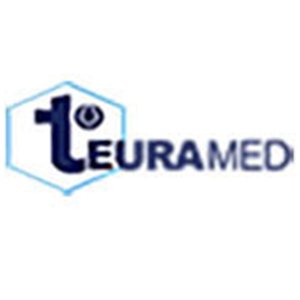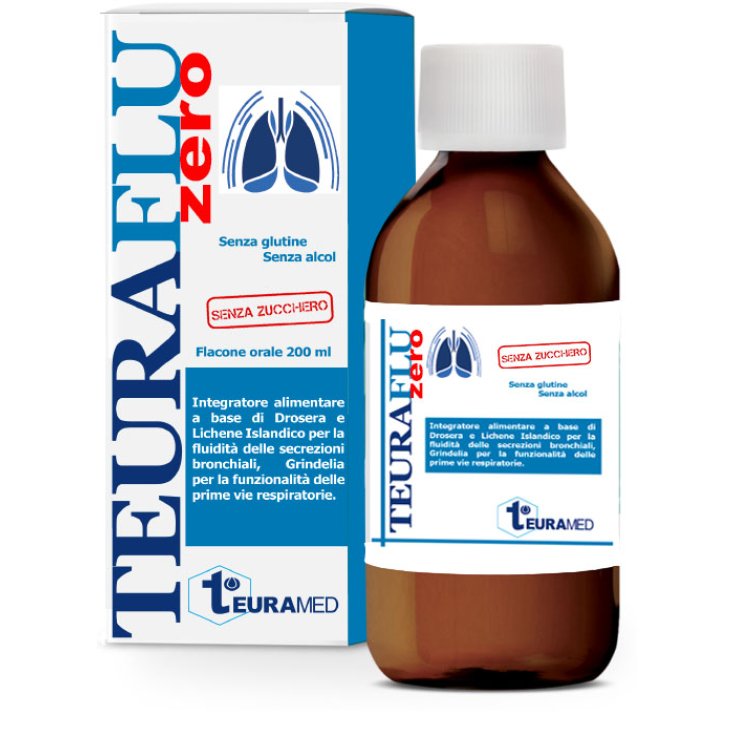TeuraFlu Zero Teuramed 200ml

- Brand: TEURAMED Srls
- Product Code: 981401932
- EAN:
- Availability: In Stock
- Purchase 3 items for 13.11€ each
- Purchase 4 items for 12.84€ each
- Purchase 5 items for 12.58€ each
TeuraFlu Zero Teuramed Food Supplement
Based on GRINDELIA, DROSERA, HELICHRIS, ICELANDIC LICHEN, EUCALYPTUS and VITAMIN C
SUGAR-FREE SWEETENED WITH STEVIA
TEURAFLU ZERO concentrated fluid promotes the fluidity of bronchial secretions. With an emollient, soothing and balsamic action, it is useful in case of pathologies affecting the upper respiratory tract, such as dry cough, fat cough, sore throat and lowering of voice.
IT DOES NOT CONTAIN SUGARS.
Indications for use
We recommend taking 5 ml of product up to 4 times a day, when needed, pure or diluted in a little water. Shake the bottle before use.
Interactions or side effects
There are no known interactions or side effects related to the use of the product; avoid in case of ascertained hypersensitivity to one or more ingredients of the product.
HEALTHY PROPERTIES OF THE INGREDIENTS
MAUVE
Mallow is generally indicated in all inflammatory states. Due to its soothing and mild astringent properties it is ideal for irritations of the oropharyngeal cavity, in dry and irritated coughs, in affections of the bronchial tree. Similarly it is indicated in inflammations of the gastrointestinal tract (gastroenteritis, colitis), for the regulation of the intestine and as an antispasmodic; it has laxative properties and its intake is recommended in subjects suffering from chronic intestinal constipation.
From the chemical point of view, the mucilages are formed by heterogeneous polysaccharides, which in contact with water dilate, forming colloidal solutions, viscous but not adhesive (a characteristic, the latter, which differentiates them from gums). It is also proven to be effective in counteracting inflammation of the respiratory tract (expectorant and antitussive properties), irritation of the digestive tract and intestinal inflammation. This activity, as in other mucilage-based plants, is performed locally on the moss with three main concomitant mechanisms: local anti-irritant, through the mechanical neutralization of the irritant, adsorbent of toxic substances and regenerates the hydration state of the mucosal surface. . At the same time, moreover, the mucilage adsorbs the secretions, neutralizing the pathological degradation products. The mechanical action of the mucilage is accompanied by the anti-inflammatory action of Malvina, a substance present in the flower.
GRINDELIA
Grindelia is a herbaceous plant native to California: used by American Indians since ancient times, it was introduced in Europe by Jesuit missionaries. The drug consists of the flower heads, which contain various active ingredients: among the most important functional principles contained are diterpenic acids (in particular grindelic acid), triterpene saponins and flavonoids. Grindelia possesses antispasmodic properties due to its ability to desensitize nerve endings at the level of the bronchial tree. Antibacterial properties are attributed to the resinous fraction, while due to the presence of saponins it has a balsamic and expectorant action.
DROSERA
Drosera is a small carnivorous plant typical of the swampy areas of northern Europe, Siberia, Japan, Korea and North America. The botanical name refers to the deceptive drops of mucilage present on the leaves, similar to morning dew (from the Greek “droserà”, covered with dew). The active part of Drosera is the aerial portion, which contains enzymes, naphthoquinones and flavonoids. It has been shown in experimental models that the naphthoquinones contained in Drosera (plumbagin, ramentone, ramentaceone) possess antispasmodic properties. Flavonoids, on the other hand, exhibit anti-inflammatory activity. Traditionally, Drosera has been used for the treatment of diseases of the lower respiratory tract, such as bronchitis (which causes dry cough) and asthma; the German Commission E approved the use of Drosera for whooping cough and coughs caused by irritative stimuli.
HELICRIS
Perennial herbaceous plant with a compact habit: it has its maximum diffusion in the Mediterranean area, especially in central-southern Italy and in the islands. The flowering tops and inflorescences are used for their choleretic and anti-inflammatory properties: the essential oil contained in the aerial parts is considered useful for treating respiratory tract diseases.
ICELANDIC LICHEN
The Icelandic Lichen is about 10 cm high, typical of mountainous soils, but also present on the trunks of trees. Lichen (Cetraria islandica) is made up of 50% mucilages that can be chemically classified as polymers of D-glucose: lichenins and isolichenins, respectively α-glucans and β-glucans. Lichen is used in formulations intended to treat respiratory diseases: the solution, inside the oral cavity, remains adhered to the mucosa and acts as a physical barrier against external agents. The high percentage of polysaccharides, in addition to having filming properties, exerts an effective moisturizing and emollient action. Icelandic Lichen has also been approved by the German Commission E for the treatment of inflammation of the oropharyngeal mucous membranes and related dry cough.
EUCALYPTUS
Eucalyptus essential oil is obtained by steam distillation and subsequent rectification of the leaves of the branches or terminal twigs of Eucalyptus globulus Labill (Myrtaceae) or other species of Eucalyptus rich in cineol. Indigenous to Australia, it is grown in the subtropical regions of the earth, including Africa, South America and Asia, southern Europe and the United States of America. The main constituent is 1,8-cineole (54-95%). In addition, modest amounts of α-pinene (2.6%), p-cymene (2.7%), aromadendrene, cuminaldehyde, globulol and pinocarveol are present. Eucalyptus essential oil is used for the symptomatic treatment of cough and phlegm: it has a sedative, anti-inflammatory, fluidifying and balsamic action.
C VITAMIN
Vitamin C (Ascorbic acid) is certainly the most studied and known vitamin: it is present in some foods, together with bioflavonoids, especially in green leafy vegetables and citrus fruits, particularly concentrated in the Amazon cherry fruit (acerola) and in rose hips. . It increases the resistance of the organism, strengthens the function of phagocytes, increases the production of antibodies, stimulates the synthesis of interferon, the biosynthesis of carnitine, destroys oxygenated free radicals, participates in the processes of cellular respiration, intervenes in the development of fibroblasts, in the synthesis of collagen, in the formation of adrenal hormones, promotes the absorption of iron, zinc, calcium, magnesium, and counteracts the toxic effects of various substances, such as nitrogen compounds and bacterial toxins.
Vitamin C is therefore of vital importance for strengthening the body's defenses.
BROMELAIN
Bromelain is a proteolytic enzyme, obtained from Pineapple. Bromelain has anti-inflammatory properties: at the level of inflammatory tissue it reduces vasodilation, increase in capillary permeability, leukocyte migration and local pain by inhibiting the formation of bradykinin and serotonin.
Particularly useful in inflammatory states due to trauma or localized inflammation where the presence of edema persists.
RUTINA
Rutin is a natural bioflavonoid composed of the flavonol quercetin and the disaccharide rutinose and is very abundant in the plant kingdom. In fact, this glycoside is found in many products such as: nuts, fruit, pulp and peel of orange, garlic, grapes, lemon, lime, peaches, apples, such as green and yellow peppers, onions, broccoli, parsley, black tea, whole grains etc ... Many studies report a surprising physiological and pharmacological activity of rutin both in in vivo and in vitro systems. The most important activities that this molecule has are: anti-inflammatory, antimicrobial, anti-tumor and anti-asthmatic; these properties are due to the ability that rutin has to inhibit free radicals that are physiologically formed inside cells. Furthermore, it is very interesting to observe that rutin was found to be much more stable against oxidation than aglycone (quercetin). Rutin is often used in association with ascorbic acid because it increases its absorption and therefore enhances its antioxidant activity. The powerful antioxidant activity of rutin is due to the presence of 2 phenolic rings which have free hydroxyls and therefore can inhibit radical reactions. At a concentration of 0.05mg / ml, rutin is able to inhibit radical reactions by 90.4%, this result is comparable with the activity of Vitamin C which, at the same concentration, is able to reduce radicals by 92.8 %, on the contrary, rutin is able to double the antioxidant activity of BHT, which is able to inhibit the radical reaction by 58.8%. Rutin can be a good anti-inflammatory molecule as it is capable of inhibiting the transcription of over 20 genes that encode pro-inflammatory proteins such as TNF-alpha, IL-1, IL-8.
HYALURONIC ACID
Hyaluronic acid (HA) is a polysaccharide. It is a large, negatively charged linear polymer composed of the repetition of disaccharide units of D-glucuronic acid and N-acetyl-D-glucosamine [(1 → 3) -β-D-GlcNAc- (1 → 4) -β-D-GlcA-] n, joined together by β-1,4 and β-1,3 glycosidic bonds. It is the main component of the extracellular matrix (ECM), belongs to the family of glycosaminoglycans (GAG) and is a very large molecule. Inside our organism we find it distributed in the form of salt and in high concentrations mainly in the connective tissue, in the skin, in the umbilical cord, in the synovial fluid, in the vitreous humor, but also in the lungs, kidneys, brain and muscles. Over the past 20 years, significant progress has been made in understanding the role of HA in both physiological and pathological conditions, as well as the biological mechanisms that regulate its synthesis, degradation and multiple biological activities.
Hyaluronic acid performs its function by covalently binding to a variety of proteins, called ialaderins, affecting their function. These proteins are called binding proteins and include CD44, RHAMM, TNFIP6, Brevicano, SHAP, LYVE1 receptors, among others. Some of these are found in the extracellular matrix (ECM), some related to cell membranes. Scientific studies indicate that, among the various receptors, CD44 is the most widely represented HA-binding membrane protein. It is a glycoprotein widely expressed in different cell types, and in particular it is abundant in macrophages. Many of the properties recognized to hyaluronic acid seem to be due precisely to the ability to interact with CD44. In fact, the interaction with this receptor plays an important role in the development and resolution of inflammation and in the activation and recruitment of T cells. Furthermore, HA is able to influence behaviors such as cell proliferation, differentiation and migration. Due to its characteristics, this macromolecule is able to retain large quantities of water, maintaining the elastic-viscosity and the transport of water in the connective tissue, the lubrication of the synovial fluid in the joints or of the vitreous body in the eyes.
GREEN TEA
Tea is an evergreen shrub belonging to the Theaceae family, native to South East Asia; from its leaves tea is obtained, the most widespread drink on the planet, after water. Tea leaves contain albuminoid substances, polyphenols, chlorophyll, cellulose, resins, waxes, tannins, essential oils, caffeine (called in this case theine); Green tea contains numerous polyphenolic substances, which are powerful antioxidants, helping to fight cell oxidation that leads to the formation of free radicals, one of the factors responsible for cellular aging and the inflammatory response.
Ingrediants
Waterfall; Grindelia (Grindelia robusta Nutt.) Aerial parts with glyceric extracted flowers; Mallow (Malva sylvestris L.) flowers and leaves glyceric extract; stabilizer: glycerol; Sundew (Drosera rotundifolia L.) aerial parts with flowers dry extract; Helichrysum (Helichrysum italicum (Roth.) G. Don.) Aerial parts with flowers dry extract; Icelandic lichen (Cetraria islandica (L.) Ach.) Thallus dry extract; thickener: carboxymethylcellulose; Rutina; Bromelain; acidifier: citric acid; preservative: potassium sorbate; green tea polyphenols (Camellia sinensis Kuntze) leaves; sweetener: steviol glycosides; L-ascorbic acid (vitamin C); aroma, hyaluronic acid; Eucalyptus (Eucalyptus globulus Labill.) Leaves essential oil.
Warnings
Do not exceed the recommended daily dose. Keep out of the reach of children under 3 years of age. Food supplements are not intended as a substitute for a varied and balanced diet and a healthy lifestyle.
storage
Keep tightly closed in a cool and dry place, away from light. The expiry date refers to the product properly stored, in unopened package. Being natural, the product may have a deposit on the bottom. This does not affect its quality and integrity.
Format
200ml bottle.

